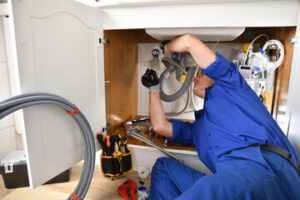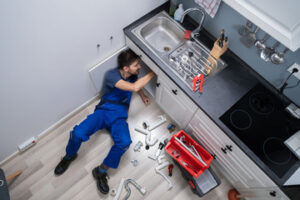A septic tank is an underground container where wastewater flows for basic sewage treatment. Solid wastes, such as grit, unconsumed food particles and soil, sink to the bottom of the tank to form a sludge layer. Oil and grease float to the top of the tank, and the clarified liquid, called effluent, exits the tank into an absorption field. Click https://www.septictankarmadale.com.au/ to learn more.
Septic tanks are large containers where household wastewater and waste matter go to be treated and disposed of. The tank sits underground and is made of fiberglass, polymers or other weather-resistant materials. Most septic tanks have a baffle in the center that separates solid waste from liquid wastewater. Oils and other substances that are lighter than water float on the top of the septic tank, which is known as the scum layer. Solid waste, like sand and grit, sinks to the bottom of the tank, which is referred to as the sludge layer. Bacteria inside the septic tank breaks down these waste particles. Then, a liquid layer emerges that is called the effluent. This is the wastewater left over after the scum and sludge layers have separated from each other. It flows out of the septic tank outlet into the absorption field, which is a shallow area of sand and rock that filters untreated wastewater before it seeps into groundwater or waterways.

The wastewater that enters the septic tank comes from drains in your home, including toilets and tubs. The wastewater leaves through inlet and outlet tees. The tees are placed below the scum layer and above the sludge layer. This creates hydraulic pressure that forces wastewater up the tees and out of the tank. The tees also prevent wastewater from backing up into your home’s drains.
A septic system is an alternative to municipal sewer systems. It’s more environmentally friendly and allows people to live farther away from cities. However, it’s important to have your septic tank inspected and pumped periodically to prevent sewage backups and environmental contamination. You can do this by paying attention to signs that your septic tank is about to fail, such as unusual odors or slow draining.
The main disadvantage of a septic system is that it costs more to maintain than a home with a municipal sewer connection. This includes inspections and maintenance, as well as the cost of having the septic tank pumped every one to four years. In addition, the septic system can contaminate groundwater and pollute well water if it fails.
Septic Tank Installation
When installing a new septic tank, it is important to work with an experienced company. They will be able to recommend the right tank size for your house and will make sure that it is located in the best place for optimal functionality. They will also be able to tell you whether the septic system is suitable for your land, including any restrictions that may be in place in your area.
The first thing that will need to be done is to dig a hole that will be large enough to hold the tank and any associated pipes. Once this has been completed, a concrete or plastic tank is then lowered into the hole and the pipes are installed around it. Gravel is then packed around the pipes to keep them in place and to help with drainage. It is important that the inlet and outlet pipes slant downward continuously toward the septic tank. This is to ensure that all wastewater makes it into the septic tank, rather than leaving solid waste behind in the drain fields.
Once the wastewater enters the septic tank, it begins to settle and separate. The heavier masses sink to the bottom, where they are digested by bacteria. The lighter masses, such as grease and oils, rise to the top of the tank, where they form a scum layer. The liquid in between, called effluent, exits the tank through the outlet and into the absorption field.
While the septic tank is doing its job, it should not be disturbed. If the septic tank becomes damaged, it can cause a lot of problems for your home and yard. However, there are some things that you can do to prevent this from happening.
One thing that you can do is to map out the location of your septic tank and any other components of your septic system. This will allow you to know where the tanks are and will prevent you from accidentally damaging them while performing yard or home maintenance. You should also be careful not to drive or park heavy vehicles or equipment over the septic tank or its components. This can damage or contaminate the water that is pumped out of your tank.
Septic Tank Repair
Your septic tank takes care of waste from your home’s drains, but it cannot take care of everything. If you’re experiencing a problem with your septic system, it’s important to schedule repairs quickly to avoid costly damage to your home and yard.
A septic tank can be repaired using various methods depending on what’s causing the issue. Some of the most common problems include:
The septic tank’s inlet and outlet pipes can become clogged with debris. When this occurs, wastewater is not able to flow through the system. This can cause sewage to back up into toilets and sinks. Cleaning these pipes can help to restore proper wastewater flow and reduce unpleasant odors.
Your septic system’s bacterial population can die off after prolonged periods of inactivity. This causes the bacteria to not break down waste as efficiently. This is why it’s important to have your septic tank pumped regularly to keep the bacterial population healthy.
The baffles in your septic tank can become damaged. These prevent the septic tank walls from being clogged with solid material. Replacing the baffles is usually necessary for the septic system to function properly.
Sludge is the dark, dense layer of sunk-in waste that settles on the bottom of the septic tank. It is made up of soil, grit, and unconsumed food particles. The septic tank’s inlet pipes carry the wastewater and sludge from your house to the septic tank, where it’s separated into three layers. The septic tank’s pump pushes the sludge into your absorption field.
If you’re noticing a foul odor in your house, the chances are good that your septic system is overflowing. This is a sign of a clog that needs to be cleaned out as soon as possible to avoid sewage from spilling into your home.
A septic tank can be made out of concrete or plastic. The former is more durable and can resist cracks and corrosion better than the latter. However, it can also be more expensive to install and repair.
Septic Tank Maintenance
A septic tank needs time to process wastewater, and this is why it’s important to space out your showers, laundry, and dishwasher use. Putting too much water into the system at once can push scum and sludge to the drain field before it has a chance to settle. This can cause a backup in your toilets and drains.
In addition to regular pumping, septic tank maintenance includes using a bacteria culture to keep the good bacteria active. The bacterial population helps break down waste in the tank, which in turn keeps the liquids flowing properly. The bacteria culture comes in a powder that’s easy to add to your toilet and can be purchased at most plumbing supply stores. It’s also a good idea to avoid using chemical drain cleaners, which kill the healthy bacteria and can damage the septic tank.
Another aspect of septic tank maintenance is keeping trees and shrubs away from the septic tank, pipes, and drain field. The roots of these plants can grow into the drain line and clog it, which leads to sewage back up into toilets and drains. It’s a good idea to plant septic-safe plants and grass around the drain field, which will help prevent this problem.
Septic tank maintenance also includes monitoring for signs that it’s time to get the septic tank pumped again. You should have it pumped every two to five years, depending on the size of your tank and how many people live in your home. It’s also a good idea for homeowners to only flush septic-safe items like toilet paper and biodegradable cleaning products. Anything else can clog the drain lines and lead to sewage backflow in your home.
If your septic tank is underground, it looks like a large metal or plastic box. It has inspection ports, typically covered by green caps, and larger manhole access ports for pumping. The top of the tank has baffle walls that separate compartments, and a network of perforated pipes extends into the drainfield soil. A filter in the outlet baffle prevents sludge and scum from leaving the tank and clogging downstream components.

